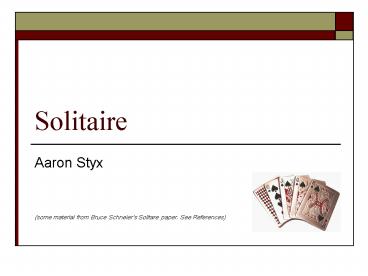Solitaire - PowerPoint PPT Presentation
1 / 18
Title:
Solitaire
Description:
Solitaire. Aaron Styx (some material from Bruce Schneier's Solitare paper. ... Uses standard deck of 52 cards 2 jokers. Strong Security ... Also called ... – PowerPoint PPT presentation
Number of Views:877
Avg rating:3.0/5.0
Title: Solitaire
1
Solitaire
- Aaron Styx
- (some material from Bruce Schneiers Solitare
paper. See References)
2
Overview
- History
- Basics
- The Key
- The Key stream
- Encryption
- Decryption
- Cryptanalysis
3
Solitaire Background
- Bruce Schneier
- Paper/pencil cipher
- Pontifex
- Cryptonomicon Neal Stephenson
4
Solitaire Basics
- Uses standard deck of 52 cards 2 jokers
- Strong Security
- Dont re-use key
- (A K) (B K) A B No Key Needed!
- Stream Cipher
- Output-feedback mode
- Also called key-generator
- Plain text converted to numbers ? added to key
stream ? converted back to letters - Can only use letters
- No spaces
- No punctuation
5
Stream Cipher
- Also called State Cipher
- Data encrypted one character at a time
- Uses pseudorandom key stream
- Successive elements of key stream are generated
automatically based on some initial state
6
The Solitaire Key Stream
- Initial ordering of deck is used as key
- Key / key stream
- 54! (2.31x1071) possible orderings
- Unique jokers
- Call them A and B
7
Key Stream cont.
- Step 1
- Move Joker A down 1 card
- If Joker A is on the bottom of the deck, move it
just below the top card. - Step 2
- Move Joker B down 2 cards
- If Joker B is bottom card, move it to 3rd from
top - If Joker B is second to bottom, move it just
below the top card
8
Key Stream cont.
- Example (from Shneiers paper)
- Before step 1 A 7 2 B 9 4 1
- After step 2 7 A 2 9 4 B 1
- Another Example
- Before step 1 3 A B 8 9 6
- After step 2 3 A 8 B 9 6
- Order matters!
9
Key Stream cont.
- Step 3 Triple Cut
- Joker locations determine where you cut
- Swap top cards with bottom cards
- Before Cut Top P1 (J)P2(J) P3
- After Cut Top P3 (J)P2(J) P1
- Jokers dont move
- Move empty packets regardless
10
Key Stream cont.
- Example
- Before cut B 5 8 7 1 A 3 9
- After cut 3 9 B 5 8 7 1 A
- Deck can remain unchanged
11
Key Stream cont.
- Suits have order
- Sheepshead order ? ? ? ?
- Bridge order ? ? ? ?
- Or any other order. Be consistent
- Schneier uses bridge order
- ? 1-13
- ? 14 26
- ? 27 39
- ? 40 - 52
12
Key Stream cont.
- Step 4 Count Cut
- Convert bottom card to a number 1..53
- Both Jokers 53
- Example A? 1, 9? 35 (w/ bridge ordering)
- Count into the deck the number of cards
corresponding to the bottom card - Cut the deck, leaving the bottom card on the
bottom of the deck - Why?
13
Key Stream cont.
- Example
- Before cut 8 4 75 3 2 61 9
- With the 3 being the 9th card from the top
- After cut 3 2 6 1 8 4 75 9
14
Key Stream cont.
- Step 5 Getting an output card
- Look at top card ? convert to number
- Count down through deck that number of cards
- Card after last card counted is output card
- Convert to number, but only want 1 26
- Ace-clubs King-diamonds 1 26
- Ace-hearts King-spades 1 26
- Number corresponds to letter of alphabet 1A,
2B, etc - This number/letter is the first in the Key Stream
15
Key Stream cont.
- Step 5 does not modify the deck order!
- Steps 1 5 are repeated for every character in
the plain text - Dont re-key the deck after getting each Key
Stream number
16
Putting it all together Encryption
- Split plain text into 5 character groups w/o
spaces - Generate the same number of key stream letters as
characters in the plain text - Convert both plain text and key stream into
numbers - Add plain text to key stream and mod 26
- Result is encrypted text
17
Decryption
- To decrypt, generate the same key stream by using
the original keyed deck - The original deck is the private key
- Simply subtract the key stream from the encrypted
text
18
Considerations
- Randomly shuffled deck is best
- Receiver must also know what this order is
- Still have key distribution problem
- No Mistakes!
- Studies of the method show that Solitaire has a
bias - Can be done on computer as well































